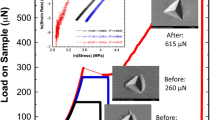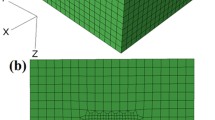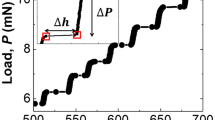Abstract
The microhardness of Si (MP 1688 K), GaP (1623 K), GaAs (1510 K) and InP (1327 K) single crystals was determined by indentation (Vicker's hardness, VHN) of low-index facets at loads of 5–100g at 296–673 K, complementing earlier work on Ge and InSb. In the brittle range, extending up to about 0.35 T melt (K), cracking occurred preferentially along the diagonals of the indentations, and was observed at all loads, with the possible exception of the lowest (5 g) in the case of InP at 289 K. At higher temperatures the relative orientations of crack and slip traces on the crystal surface, as observed by SEM, suggested that cracks nucleated preferentially at the slip-band intersection, as was also noted by Hirsch et al. (Phil. Mag.3 (1985) 759) in GaAs above 600 K. As earlier in Ge, the VHN was found to depend on the load, L, as L p, and on the indentation diameter, d, as dn, with p = 1/2 and n = 2, as required by the model of indentation plasticity of Banerjee and Feltham [4, 5], but higher p and n values were found if chipping at the indentation edges was evident. The effect was related to the resulting decrease in indentation diameter due to the work lost, through chipping, by the indenter. Above about 0.35 T melt (K), relaxation of the dislocation structures entails a decrease of p and n; both parameters tend to zero as T → T melt. Shear and tensile stresses seem to co-operate in the process of plastic deformation, the role of normal stresses, acting across slip planes, predominating in the ‘brittle’ range.
Similar content being viewed by others
References
H. Alexander and P. Haasen, Solid State Phys.22 (1968) 27.
P. Feltham, Abh. Ak. Wiss. DDR (Abt. Math., Naturwiss., Techn.) 1N (1978) 42.
P. B. Hirsch, in “Dislocations and Properties of Real Materials”, edited by M. H. Loretto (Institute of Metals, London, 1985) p. 343.
R. Banerjee and P. Feltham, J. Mater. Sci.9 (1974) 1478.
Idem, ibid.11 (1976) 1171.
M. J. Hill and D. J. Rowcliffe, ibid.9 (1974) 1569.
P. B. Hirsch, P. Pirouz, S. G. Roberts and P. D. Warren, Phil. Mag. B52 (1985) 759.
B. C. De Cooman and C. B. Carter, Phys. Status Solidi A112 (1989) 473.
Idem., Phil. Mag. A60 (1989) 245.
N. D. Theodore, B. C. De Cooman and C. B. Carter, Phys. Status Solidi A114 (1989) 105.
I. I. Khodos, M. S. Shiksaidov, I. I. Snighireva, A. P. Uksharova and V. I. Mikhailovitch, ibid.114 (1989) 113.
J. Völks, Phil. Mag. A61 (1990) 233.
P. Brown, J. Rabier and H. Garem, ibid.61 (1990) 619, 647 and 673.
P. B. Hirsch, S. G. Roberts, J. Samuel and P. D. Warren, in “Strength of Metals and Alloys”, edited by P. O. Kettunen (Pergamon, Oxford, 1989) p. 1083.
V. I. Barbashov and T. V. Rodzina, Phys. Status Solidi A115 (1989) K143.
R. Wagatsuma, K. Sumino, W. Uchida and S. Yamamoto, J. Appl. Phys.42 (1971) 222.
A. Ourmazd, P. R. Wilshaw and G. R. Booker, J. De Phys. (Paris)44 (1983) C4–51.
M. Z. Butt, K. M. Chaudhary and P. Feltham, J. Mater. Sci.18 (1983) 163.
P. B. Hirsch and S. G. Roberts, Phil. Mag. A.64 (1991) 55.
Y. Tsunekawa and S. Weissmann, Metal Trans.5 (1974) 1585.
V. G. Eremenko and V. I. Nikitenko, Phys. Status Solidi A14 (1972) 317.
Author information
Authors and Affiliations
Rights and permissions
About this article
Cite this article
Feltham, P., Banerjee, R. Theory and application of microindentation in studies of glide and cracking in single crystals of elemental and compound semiconductors. J Mater Sci 27, 1626–1632 (1992). https://doi.org/10.1007/BF00542926
Received:
Accepted:
Published:
Issue Date:
DOI: https://doi.org/10.1007/BF00542926




